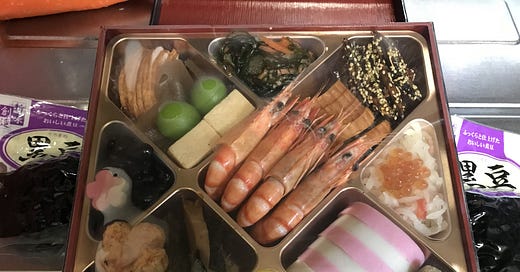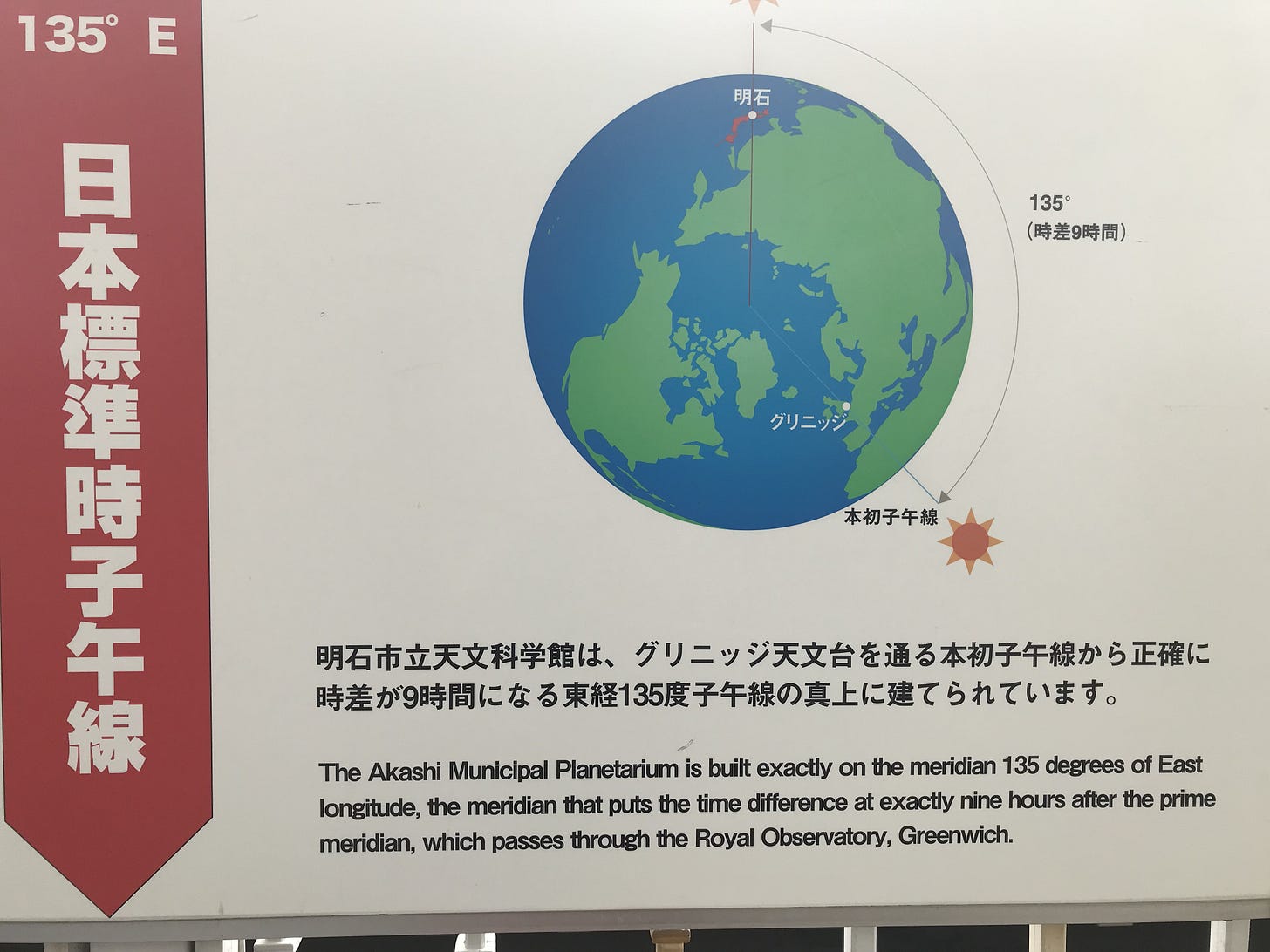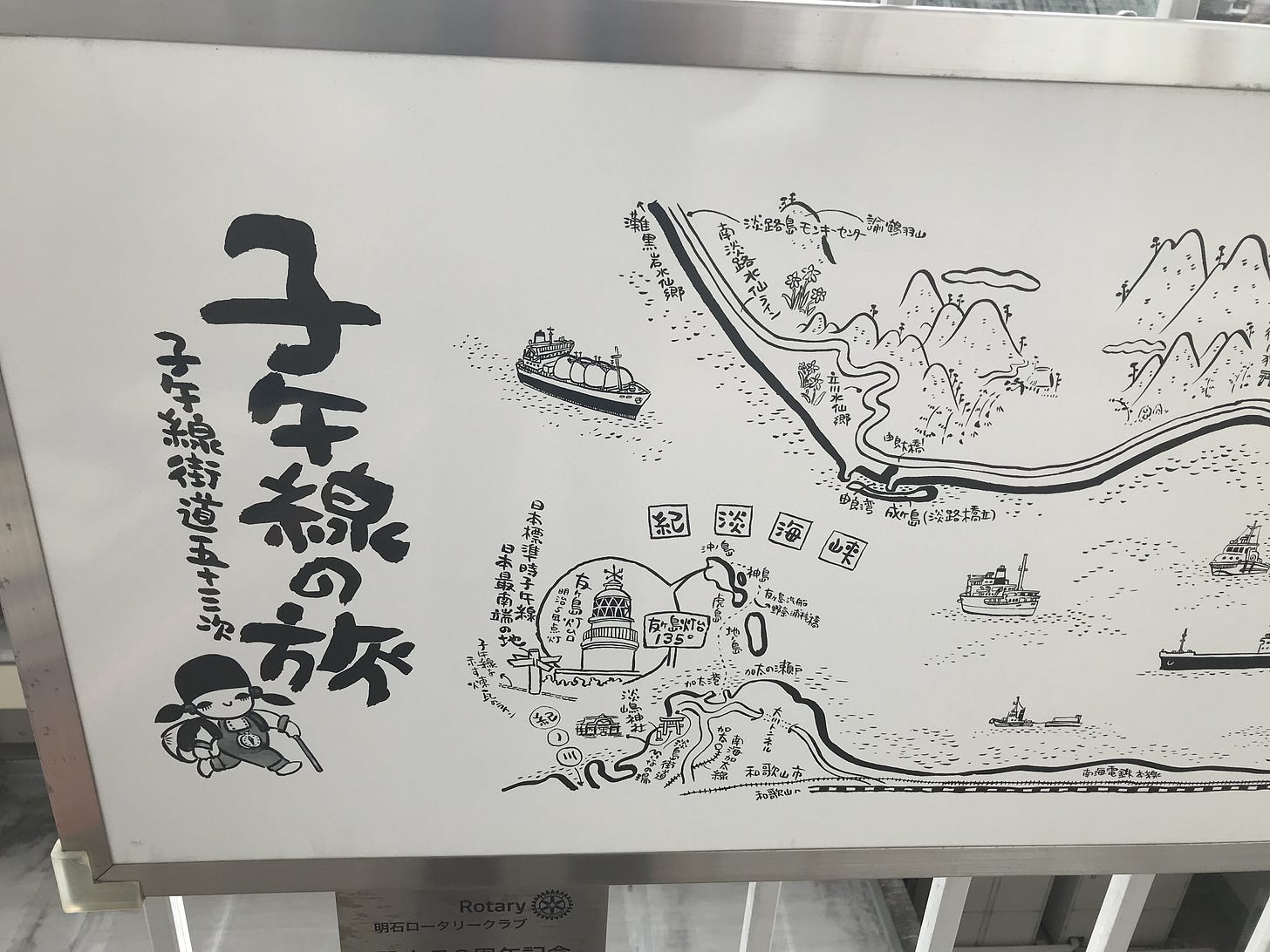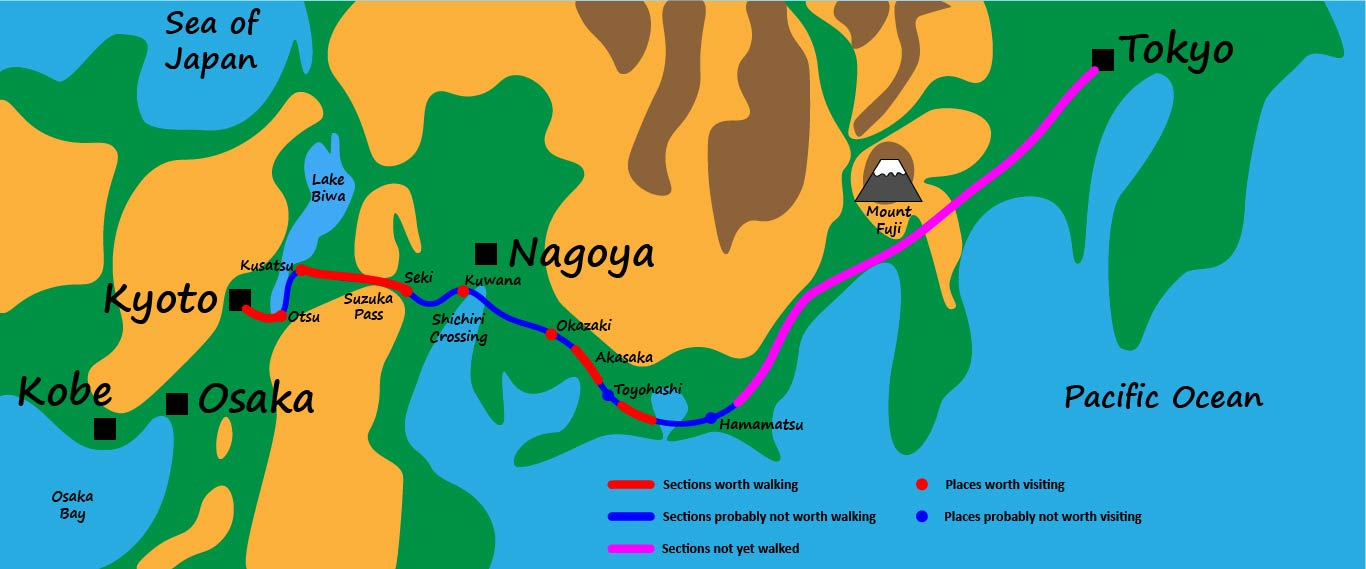A Happy New Year to all our readers! Thank you for subscribing to Walking Across Japan. It’s almost time here for the annual Kohaku singing competition on TV, an obligatory shrine visit, and lots of osechi food.
Traditional osechi food for New Year just waiting for New Year’s Day morning to be broken out of its wrapping!
I hope you have enjoyed the content so far. Last year’s posts were all about the Tokaido, the main route from Tokyo to Kyoto for a large period of Japanese history. Nowadays, it connects most of the significant urban areas of Japan (Kansai, Nagoya area, Kanto) in an almost continuous belt of cities, towns and suburbs with only the odd patch of countryside between. I’ve been walking the Tokaido in snatches for nearly three years. As I’ve got farther from Kyoto, it’s become more difficult to find the time to complete further sections, but in 2023, I hope to continue through Shizuoka prefecture, past Mount Fuji, and onwards to Tokyo.
This New Year vacation, I aim to complete another walk I started about a year ago. When I visited a nearby planetarium in Akashi, near Kobe, I my attention was caught by a long series of panels outside depicting the route of Japan Standard Time (JST) through the middle of Japan. In the UK, Greenwich Mean Time passes through the capital, London. The JST doesn’t pass through Tokyo, instead it passes right through the centre of Japan, through the relative obscurity of Akashi on the Inland Sea, up to the wild and scenic Japan Sea coast. There’s no official walking route for this, but this gave me the freedom to make my own route, unconstrained by the constant checking I was on the right road as I was on the Tokaido.
The Tokaido walk is all about business, industry and the history of the main road between the two Japanese capitals. The JST walk on the other hand, will be all about the city and countryside, the problem of depopulation, the situation with agriculture and forestry, and anything else I encounter. Akashi is an example of a city that, under a dynamic mayor, has succeeded in attracting young families and resisting population decline. The countryside of Hyogo, though, is experiencing the full brunt of this decline.
I will probably try to get back to walking the Tokaido during the Golden Week holidays in May. Until then, I will shift my writing to the JST walk. Before we leave the Tokaido for a while, let’s take the time to review what I’ve encountered so far.
The Tokaido really isn’t a pretty route. There are, however, towns and sections that are worth visiting or walking along the half I’ve completed so far. So I’m going to list them here:
Kyoto to Otsu: It’s worth walking this section, even if it does have a large chunk along a main road. Firstly, it’s the start (or end depending on which way you’re walking) of the Tokaido. Secondly, there’s a nice amount of industrial history - canals, tunnels and buildings that add interest along the way. It’s a good section to introduce Japanese history around the Meiji restoration period. The city of Otsu isn’t spectacular, but it’s situated in a pleasant location on Lake Biwa.
Otsu to Kusatsu: Endless suburbs with little to break the monotony. Unless you’re a masochist like me that wants to feel the satisfaction of walking the entire route, I would skip this and move onto the town of Kusatsu. This has nicely preserved sections of the Tokaido, an original honjin inn and a nice museum. Kusatsu also has a really nice park.
Kusatsu to Seki: One of the more rural sections of the Tokaido, it’s well worth walking. You’ll go through nice villages, past tea farms, and over a forested pass to Seki. It gives you a good taste of what rural Japan has to offer away from the tourist spots. Seki has a great street full of old houses, it’s probably the best preserved post town along the Tokaido.
Seki to Kuwana: Unless you have a passion for modern industry and endless suburbs, steer clear of this section. Kuwana has a nice castle and park area, and is probably worth a quick stop for that. All of these towns I’ve mentioned have train stations, so getting from one place to another is pretty easy!
Kuwana to Okazaki: Another section to skip walking. Arimatsu with its tie-dying and well-preserved buildings is worth visiting. Okazaki has a really nice park and castle. You can also visit miso factories there - so worth spending at least half a day there.
Okazaki to Toyohashi: Again, not really worth walking most of it. However, there is a really nice section from Nagasawa to Goyu, near Toyokawa, that is a very pleasant walk. Here, the Tokaido drops down from a mountain pass, through several villages along minor roads. Along the way is Akasaka, with well-preserved buildings, an interesting museum and a nice park. You can get to this section from Meiden-Nagasawa and Goyu stations on the Meitetsu-Nagoya train line.
Toyohashi to Hamamatsu: Not worth walking most of it. A section along the Pacific coast from Shirasuka to Arai is possibly worth walking. There are some good views of the Pacific and it’s off the main road. Unfortunately, Shirasuka is far from a train station, although Arai does have a train station. Toyohashi and Hamamatsu aren’t really worth visiting in my opinion. Both cities have castles, but they aren’t anywhere near the league of say Himeji Castle.
What surprised me about the Tokaido? There are so many factories! I checked along the route of the Great North Road in the UK, an equivalent road to the Tokaido in many ways. The Great North Road ran between two capitals (London and Edinburgh), and was the main route prior to the railways for those wishing to travel north or south across the island. It was widely used for postal services, as was the Tokaido. I could only find one very large factory employing more than 5000 employees - Nissan in Washington, Tyne and Wear. There were other manufacturers - Ebac (washing machines and dehumidifiers), Husqvarna (gardening machinery), but these only employed around 1000 people each. On the Tokaido, I passed many factories the size of Nissan’s, with lots of associated parts manufacturers too. In the UK, pretty much every manufacturer that is trying to compete globally seems to have offshored production or closed down. A large Cummins factory in Stamford, Lincolnshire closed in 2017 due to intense competition, shifting most of the work to its factory in Romania. What manufacturing industry remains in the UK is closely tied to the domestic market. Food manufacturers catering to the British palate and companies making kitchens or luxury horse vehicles were some of the remaining factories along the Great North Road. There are specialised engineering companies too: Airbus in Stevenage making and testing parts for space vehicles, Airborne Systems making parachutes for defence equipment and 3M making masks and respirators.
This lack of manufacturing capability could be decried - “We don’t make anything anymore!” But has Japan found a better alternative? It definitely still makes things, but seems to need to bring in lots of foreign workers to do so. Is it sustainable to bring in workers from Brazil or Vietnam to keep these industries alive for a little longer? The wages in Vietnam are rising rapidly and the weakening yen makes working in Japan a steadily less attractive option. Will it be like the bringing in of South Asian workers to work the night shifts in the Lancashire cotton mills, a temporary solution that only put off the inevitable closure for a few years and left a vulnerable community largely unemployed?
The other surprising thing I learned from the Tokaido was that Russia has long been Japan’s main enemy. The war in the Pacific against the US often overshadows this, but the Otsu incident highlights the building threat of Russia to Japan’s northeast in the mid-nineteenth century. The US is on the other side of an ocean, even if it does have military bases in Japan. Russia is much closer, Japanese maps still show the southern part of Sakhalin Island as Japanese. The continued focus of right-wing groups such as the Kikumori Youth League on Russia shows how distrusted the country remains for many Japanese. The two countries remain technically at war, and Russia’s invasion of Ukraine can’t have helped Japanese feelings towards Russia.
The next newsletter will be about the start of the Japan Standard Time walk, from Akashi to Miki in the south of Hyogo Prefecture.
Best wishes again for the New Year!










I recently discovered your newsletter and I'm thoroughly enjoying your (mis)adventures. And I can relate to that kind of travel: long walks, legs cramps and all that. I've never been to most of the places you are writing about so I've learned many new things.